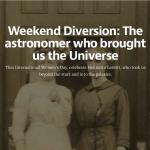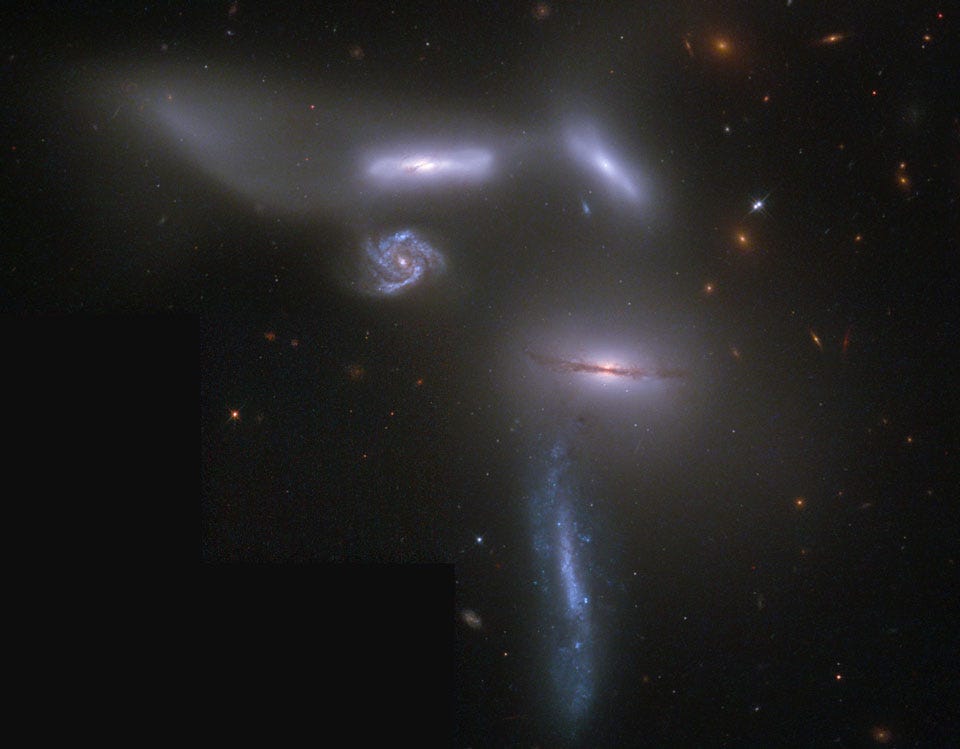The Astronomer Who Brought Us the Universe

“Her will tells nearly all. She left an estate worth $314.91, mostly in Liberty Bonds, with a few items such as a desk valued at $5. She never married and had few living relatives. She also left behind a legacy of a great astronomical discovery.” -Jeremy Bernstein, on Henrietta Leavitt
If you go back to the early 1900s and before, you’ll find a huge body of important scientific work that laid the foundation for humanity’s discovery of exactly what the Universe is like today: where it came from, what the laws are that govern it, and how it came to be the way it is today. And yet, a huge portion of this work was accomplished by women who never received, during their lifetimes, the credit that was due them for their incredible work. Have a listen to Cat Power’s powerful version of a song that gives it a whole new meaning, Wonderwall,
while you consider one of the most glorious sights in the Universe: the galaxies beyond our own.

Image credit: Hubble Legacy Archive, NASA, ESA; Processing: Judy Schmidt, via http://apod.nasa.gov/apod/ap131210.html.
Each of those collections of million, billions or even trillions of stars is its own island Universe, filled with a collection of worlds and histories as unique and diverse as the planets in our own Solar System. Yet for centuries and millennia, we not only didn’t know what the nature of these objects were — whether they were galaxies like our Milky Way or small objects that were maybe not so distant — we had no way to measure the distances to them. Think about what you need in order to figure out how distant something must be.

Image credit: Brian Combs, via http://www.bcastropics.com/images/view/150.
For a galaxy like the ones shown above, you might think these objects are intrinsically all the same size, and hence the ones that appear smaller are farther away. But this isn’t necessarily the case: some galaxies are many thousands of times the mass and brightness of others, some are many times the physical size of others, and you can’t know how big or bright a galaxy is just by looking.
But there are some tricks we can use, if we know some property intrinsic to the galaxy itself.

Image credit: NASA/JPL-Caltech.
Imagine that you’ve got a candle (or a light bulb) whose intrinsic brightness you know. If you know how much total light that candle gives off, and you know how brightness falls off with distance (something that’s been known since at least the 1600s), all you need to do is measure how bright that candle appears, and you instantly know how far away it must be.
This idea is known as a standard candle or a distance indicator in astronomy, and it simply means if there’s some property of the object you can measure that tells you something about its intrinsic brightness, you can then figure out how far away it is.
For example, if you had a certain type of star whose intrinsic brightness you could know, then all you’d have to do was measure that star (and how bright it appeared), and then you’d be able to figure out how far away it needed to be. While we have literally over a dozen different distance indicators today, they all came about the same way: by noticing there was a relationship between some property that was easy to observe and the intrinsic brightness of an object.
The very first one? The very first way we ever uncovered to know how intrinsically bright something was based on what we could observe? We owe that to the work of Henrietta Swan Leavitt.

Images credit: Harvard College observatory, of Henrietta Leavitt (L), Leavitt along with the rest of “Pickering’s Harem” of women computers (R).

She was employed at Harvard College Observatory — like many women “computers” in the late 1800s/early 1900s — to do menial work for the male astronomers: cataloguing stars that had been photographed on observing plates.

Image credit: Annals of the Harvard College Observatory, Vol. LX, No. IV, Published by the Observatory, Cambridge, Massachusetts, 1908.
But if you’re staring at thousands upon thousands of objects, cataloguing them while examining their properties, and also, you’re brilliant, you’re bound to notice when something interesting comes up. In Henrietta Leavitt’s case, she was studying star upon star upon star in the Small Magellanic Cloud, a satellite galaxy of the Milky Way located just 200,000 light years away.

Image credit: ESA/Hubble and Digitized Sky Survey 2.
She was able to catalogue 1,777 variable stars from the photographic plates taken in the 1890s, but what she noticed in about 25 of these stars changed astronomy forever. Instead of simply measuring things like the evolution of their brightness, color, etc., she noticed that some of these stars not only varied in their brightness, but took note of how they varied: periodically, extremely regularly, and always between the same peak and trough brightnesses.

Image credit: Henrietta Leavitt, 1912.
Moreover, she was able to link these variable stars with another star known to vary in our own galaxy: the star Delta Cephei, a luminous blue star known to vary in its brightness over a certain time frame.

Image credit: NASA/JPL-Caltech/M. Marengo (Iowa State).
What she found from these 25 stars — knowing they were all located at roughly the same distance in this small nebula in the sky — was a relationship between the period of each star, how long it takes to go from brightest to dimmest to brightest again, and how intrinsically luminous that star was.
This relationship between the period and brightness of Cepheid variable stars is still used today, and was the very first correlation between an easily observable property (period of variability) and an intrinsic brightness ever noticed.

Image credit: Edwin Hubble / Carnegie Observatories, via https://obs.carnegiescience.edu/PAST/m31var.
Years later, Edwin Hubble noticed one of these star types, a Cepheid variable, in the great spiral nebula in Andromeda, discovering that this was a galaxy, and eventually leading to the discovery that not only were all the great spirals in the sky their own galaxies, but that the Universe itself was expanding. While Henrietta Leavitt’s discovery was so powerful and profound that her work could have been nominated for a Nobel Prize, with the Swedish mathematician and scientist Magnus Gustaf (Gösta) Mittag-Leffler writing the following to her:
Honoured Miss Leavitt,
What my friend and colleague Professor von Zeipel of Uppsala has told me about your admirable discovery of the empirical law touching the connection between magnitude and period-length for the S. Cephei-variables of the Little Magellan’s cloud, has impressed me so deeply that I feel seriously inclined to nominate you to the Nobel prize in physics for 1926, although I must confess that my knowledge of the matter is as yet rather incomplete.
Unfortunately, he wrote this in 1925, not knowing that Henrietta Leavitt died of cancer four years prior, never learning that her work would lead to the resolution of the mystery of spiral nebulae and the discovery of the expanding Universe.

Image credit: © SILENT SKY 2013–2015, via http://silentskyplay.tumblr.com/post/72993564376/astonishing-discoveries-await-henrietta-leavitt.
Her legacy is an incredible one, ushering in an era where astronomy went far beyond the stars and nebulae of the Milky Way, but opened up the entire Universe for scientific exploration and discovery. As fortune would have it, there’s a new play out — Silent Sky — about her life and scientific discoveries, written by award-winning playwright Lauren Gunderson. (Closing night is tonight in Atlanta, for those of you who still might catch it!)
This international women’s day, celebrate the largely unsung hero of astronomy, Henrietta Leavitt, and when you think about the vastness of the Universe in all its splendor, remember her as the woman who opened our eyes to it.

Image credit: NASA; ESA; G. Illingworth, D. Magee, and P. Oesch, University of California, Santa Cruz; R. Bouwens, Leiden University; and the HUDF09 Team.
Without her work, her attention to detail and her remarkable insight, we might never have come to understand exactly what all of this is.
